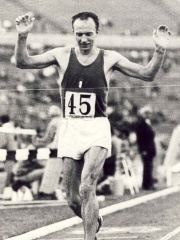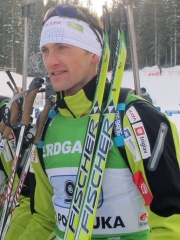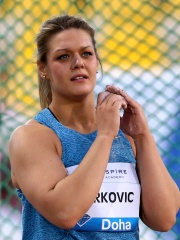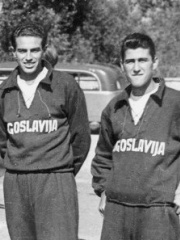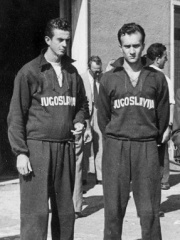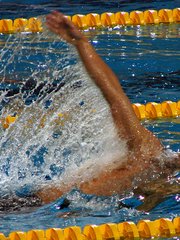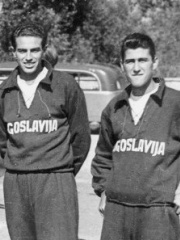
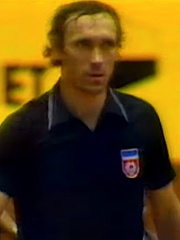
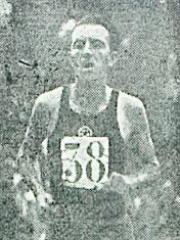
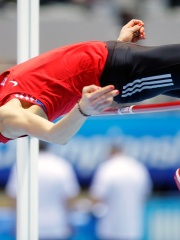
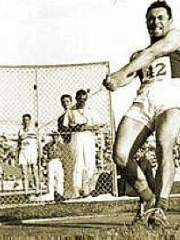
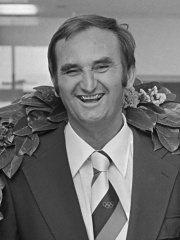
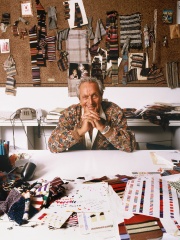
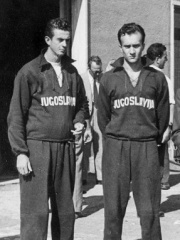
The Most Famous
ATHLETES from Croatia
Top 10
The following people are considered by Pantheon to be the top 10 most legendary Croatian Athletes of all time. This list of famous Croatian Athletes is sorted by HPI (Historical Popularity Index), a metric that aggregates information on a biography's online popularity. Visit the rankings page to view the entire list of Croatian Athletes.

1. Duje Bonačić (1929 - 2020)
With an HPI of 61.19, Duje Bonačić is the most famous Croatian Athlete. His biography has been translated into 23 different languages on wikipedia.
Duje Bonačić (10 April 1929 – 24 January 2020) was a Croatian rower who won a gold medal representing Yugoslavia in the coxless four event at the 1952 Summer Olympics. Bonačić was born in Split to an ethnic Croat father and ethnic Slovene mother. He had an elder brother Vojko and a sister Nevenka. He graduated in natural sciences in Zagreb, and took up rowing to build muscles, as he weighed only 56 kg with a height of 183 cm at the time. After retiring from competitions he worked as a professor of geography, meteorology and oceanography at maritime schools and also served as a coach and referee in rowing and sailing. After the death of Željko Čajkovski on 11 November 2016, he became the oldest Croatian Olympic medal winner. Bonačić died on 24 January 2020, at the age of 90 following a short illness.

2. Dragutin Šurbek (1946 - 2018)
With an HPI of 60.90, Dragutin Šurbek is the 2nd most famous Croatian Athlete. His biography has been translated into 22 different languages.
Dragutin Šurbek (8 August 1946 – 15 July 2018) was a Croatian and Yugoslav table tennis player and coach.

3. Franjo Mihalić (1920 - 2015)
With an HPI of 58.80, Franjo Mihalić is the 3rd most famous Croatian Athlete. His biography has been translated into 20 different languages.
Franjo Mihalić (Serbo-Croatian pronunciation: [frǎːɲo mǐxalitɕ]; 9 March 1920 – 14 February 2015) was a Yugoslav and Croatian long-distance runner best known for his 1958 win at the Boston Marathon and his marathon silver medal in the 1956 Summer Olympics. Mihalić competed mostly in marathons, road races and cross country races, distinguishing himself by winning many top-level international competitions in the 1950s and setting a combined 25 Croatian and later Yugoslavian national records in long-distance track events between 5000 m and 25 km. In 1957, he became the inaugural winner of the Golden Badge, the award for the best sportsperson of Yugoslavia awarded by the daily Sport. He is regarded as the most accomplished male athlete in the history of Croatian, Serbian and Yugoslav track and field.

4. Blanka Vlašić (b. 1983)
With an HPI of 58.15, Blanka Vlašić is the 4th most famous Croatian Athlete. Her biography has been translated into 43 different languages.
Blanka Vlašić (Croatian pronunciation: [ˈblaːŋka ˈʋlaʃitɕ]; born 8 November 1983) is a Croatian former track and field athlete who specialised in the high jump. She is a double world champion, an indoor world champion and twice Olympic medallist. Vlašić's personal best of 2.08 m (6 ft 9+3⁄4 in) is a Croatian record and joint third best mark of all time. The daughter of Croatian decathlon record holder Joško Vlašić, she was a talented junior athlete and attended her first Olympic Games in 2000 Sydney at the age of sixteen. She won the World Junior Championships in Athletics in both 2000 and 2002. Vlašić broke the Croatia national record in 2004 and also won her first world senior medal at the World Indoor Championships that year. A hyperthyroid condition hindered her second Olympic appearance in Athens and she spent the 2005 season recuperating from surgery. She returned in 2006, taking the silver at the World Indoor Championships. The 2007 season signalled a strong run of form: she won at the 2007 World Championships, became the indoor world champion in 2008 and her winning streak came to an end with a narrow loss at the Beijing Olympics that year, where she took silver. She became World Champion for the second time in 2009. Her awards also including the IAAF World Athlete of the Year 2010 and the European Athlete of the Year trophy (2007, 2010).
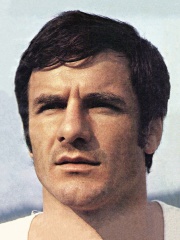
5. Milan Nenadić (1943 - 2024)
With an HPI of 57.96, Milan Nenadić is the 5th most famous Croatian Athlete. His biography has been translated into 16 different languages.
Milan Nenadić (12 August 1943 – 16 January 2024) was a Serbian middleweight Greco-Roman wrestler. Representing Yugoslavia, Nenadić competed in the 1968 and 1972 Summer Olympics and won a bronze medal in 1972. He was a European champion in 1969 and 1970 and won three medals at the world championships in 1969–1973. Being of Croatian Serb descent, he was a recipient of the silver plaque of the Serbian Wrestling Association. Milan Nenadić died on 16 January 2024, at the age of 80.

6. Ivan Gubijan (1923 - 2009)
With an HPI of 57.58, Ivan Gubijan is the 6th most famous Croatian Athlete. His biography has been translated into 20 different languages.
Ivan Gubijan (14 June 1923 – 4 January 2009) was a Yugoslav hammer thrower. He competed in the 1948 and 1952 Olympics and placed second and ninth, respectively. He is credited with introducing the four-turn throwing technique, which is widely used today. Gubijan finished second behind Duncan Clark in the hammer throw event at the British 1950 AAA Championships.

7. Ivo Trumbić (1935 - 2021)
With an HPI of 57.44, Ivo Trumbić is the 7th most famous Croatian Athlete. His biography has been translated into 18 different languages.
Ivo Trumbić (2 April 1935 – 12 March 2021) was a Croatian water polo player and Olympic medallist. He later went on to manage. Ivo Trumbić coached the Netherlands to a bronze medal at the 1976 Summer Olympics, becoming one of the few sportspeople who won Olympic medals in water polo as players and head coaches.

8. Ottavio Missoni (1921 - 2013)
With an HPI of 57.32, Ottavio Missoni is the 8th most famous Croatian Athlete. His biography has been translated into 15 different languages.
Ottavio Missoni (11 February 1921 – 9 May 2013) was an Italian businessman, founder of the Italian fashion label Missoni and an Olympic hurdler who competed in the 1948 Summer Olympics. Along with his wife Rosita, he was part of the group of designers who launched Italian ready-to-wear in the 1950s, thereby ensuring the global success of Italian fashion.

9. Mate Trojanović (1930 - 2015)
With an HPI of 57.22, Mate Trojanović is the 9th most famous Croatian Athlete. His biography has been translated into 21 different languages.
Mate Trojanović (20 May 1930 – 27 March 2015) was a Yugoslavian rower of Croat ethnicity, who won a gold medal in the coxless four event at the 1952 Summer Olympics. After completing his studies in veterinary medicine in Split he moved to Maribor, where he worked as a veterinary inspector with the Yugoslav federal customs.

10. Luciano Sušanj (1948 - 2024)
With an HPI of 56.72, Luciano Sušanj is the 10th most famous Croatian Athlete. His biography has been translated into 17 different languages.
Luciano Sušanj (10 November 1948 – 14 April 2024) was a Croatian politician, sports worker and track athlete who competed for Yugoslavia. Sušanj was successful in international competition over 400 and 800 meters, but was best known for winning the 800 meters European title in 1974. In the 1990s Sušanj started a political career, winning a seat in the Croatian Parliament in 1990 and 2000. In 2000 he was elected president of the Croatian Athletics Federation, and vice-president of the Croatian Olympic Committee.
People
Pantheon has 87 people classified as Croatian athletes born between 1920 and 2001. Of these 87, 72 (82.76%) of them are still alive today. The most famous living Croatian athletes include Blanka Vlašić, Abdon Pamich, and Jakov Fak. The most famous deceased Croatian athletes include Duje Bonačić, Dragutin Šurbek, and Franjo Mihalić. As of April 2024, 11 new Croatian athletes have been added to Pantheon including Mislav Bezmalinović, Tomislav Paškvalin, and Dubravko Šimenc.
Living Croatian Athletes
Go to all RankingsBlanka Vlašić
1983 - Present
HPI: 58.15
Abdon Pamich
1933 - Present
HPI: 54.62
Jakov Fak
1987 - Present
HPI: 53.84
Karlo Stipanić
1941 - Present
HPI: 52.97
Ozren Bonačić
1942 - Present
HPI: 51.53
Sandra Perković
1990 - Present
HPI: 49.63
Tomislav Paškvalin
1961 - Present
HPI: 46.14
Dubravko Šimenc
1966 - Present
HPI: 45.11
Josip Glasnović
1983 - Present
HPI: 44.00
Damir Burić
1980 - Present
HPI: 43.53
Igor Boraska
1970 - Present
HPI: 43.48
Siniša Skelin
1974 - Present
HPI: 42.73
Deceased Croatian Athletes
Go to all RankingsDuje Bonačić
1929 - 2020
HPI: 61.19
Dragutin Šurbek
1946 - 2018
HPI: 60.90
Franjo Mihalić
1920 - 2015
HPI: 58.80
Milan Nenadić
1943 - 2024
HPI: 57.96
Ivan Gubijan
1923 - 2009
HPI: 57.58
Ivo Trumbić
1935 - 2021
HPI: 57.44
Ottavio Missoni
1921 - 2013
HPI: 57.32
Mate Trojanović
1930 - 2015
HPI: 57.22
Luciano Sušanj
1948 - 2024
HPI: 56.72
Velimir Valenta
1929 - 2004
HPI: 54.81
Petar Šegvić
1930 - 1990
HPI: 53.67
Miroslav Poljak
1944 - 2015
HPI: 53.42
Newly Added Croatian Athletes (2025)
Go to all RankingsMislav Bezmalinović
1967 - 2024
HPI: 47.93
Tomislav Paškvalin
1961 - Present
HPI: 46.14
Dubravko Šimenc
1966 - Present
HPI: 45.11
Siniša Skelin
1974 - Present
HPI: 42.73
Tihomir Franković
1970 - Present
HPI: 42.38
Frano Vićan
1976 - Present
HPI: 40.61
Nikša Skelin
1978 - Present
HPI: 39.20
Luka Grubor
1973 - Present
HPI: 38.92
Gordan Kožulj
1976 - Present
HPI: 38.43
Igor Francetić
1977 - Present
HPI: 38.28
Stipe Žunić
1990 - Present
HPI: 34.05
Overlapping Lives
Which Athletes were alive at the same time? This visualization shows the lifespans of the 15 most globally memorable Athletes since 1700.

